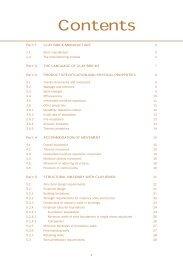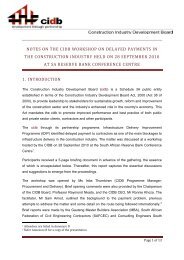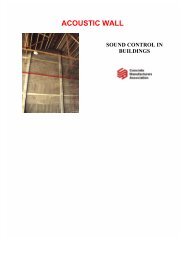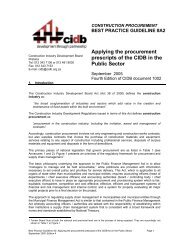MANUAL 4 - Construction Industry Development Board
MANUAL 4 - Construction Industry Development Board
MANUAL 4 - Construction Industry Development Board
Create successful ePaper yourself
Turn your PDF publications into a flip-book with our unique Google optimized e-Paper software.
MODULE<br />
1<br />
2<br />
3<br />
4<br />
5<br />
6<br />
7<br />
<strong>MANUAL</strong> 4 – BITUMINOUS PAVEMENT SEALS<br />
After the surface has been rolled once (i.e. a complete coverage of the roller), care must be<br />
taken to cover bare patches, or remove any double layers of aggregate by brooming, to<br />
obtain a single layer shoulder to shoulder.<br />
The first roll must be done without vibration but subsequent rolling, when the aggregate is<br />
properly placed with full coverage obtained, can be done with intermediate vibration of the<br />
roller switched on.<br />
The rolling must be done in straight lines, parallel to the centre line or edges of the road. It is<br />
essential that rolling is done uniformly across the width of the road surface. Typically three<br />
passes should be sufficient to seat the aggregate. (Photo 4.11)<br />
4.5 Application of penetration spray<br />
The remainder of the bitumen emulsion that was not applied in the tack coat, is now sprayed<br />
as a penetration spray.<br />
The same precautions regarding joints and protection of kerbs, drains, etc. apply, as was the<br />
case for the tack coat.<br />
If the surface is left open for any period before applying the penetration spray, the following<br />
must be attended to:<br />
• Any dust, dirt or sand blown into the surface voids, must be removed/blown out with<br />
a compressor.<br />
• The surface must be rolled once to reseat any aggregate that may have been disturbed<br />
by unauthorised traffic.<br />
The road can be opened to traffic once the emulsion has broken.<br />
IMPLEMENTING EMPLOYMENT INTENSIVE ROAD WORKS 30












